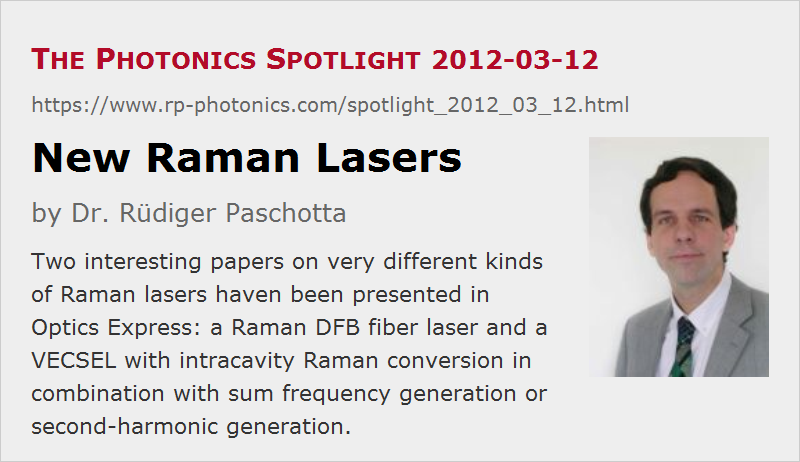New Raman Lasers
Posted on 2012-03-12 as a part of the Photonics Spotlight (available as e-mail newsletter!)
Permanent link: https://www.rp-photonics.com/spotlight_2012_03_12.html
Author: Dr. Rüdiger Paschotta, RP Photonics Consulting GmbH
Abstract: Two interesting papers on very different kinds of Raman lasers haven been presented in Optics Express: a Raman DFB fiber laser and a VECSEL with intracavity Raman conversion in combination with sum frequency generation or second-harmonic generation.

Ref.: J. Shi et al., “Highly efficient Raman distributed feedback fibre lasers”, Opt. Express 20 (5), 5082 (2012); encyclopedia article on Raman lasers; J. Lin et al., “Continuous-wave VECSEL Raman laser with tunable lime-yellow-orange output”, Opt. Express 20 (5), 5219 (2012)
Two interesting papers on Raman lasers appeared in a recent issue of Optics Express:
Raman DFB Fiber Laser
Shi et al. (see the reference above) reported a distributed-feedback laser (DFB laser) based on stimulated Raman scattering in an optical fiber. This is quite remarkable because DFB fiber lasers have to be rather short, whereas the achievable Raman gain per centimeter is rather small. One would normally think about using some special glass with high nonlinearity, e.g., a chalcogenide or tellurite glass. The authors also suggest that, but their results were obtained with quite normal germanosilicate fibers. Their solution was to make the DFB fiber lasers relatively long – 30 cm –, but short enough for stable single-frequency operation, and to make the resonator losses fairly small with suitable fiber Bragg gratings. In that way, a reasonably low threshold pump power of 1 W or 2 W, depending on the fiber, was achieved, and the slope efficiencies were also very high: in one case 93%.
VECSEL with Intracavity Raman Conversion
The other results have been presented by J. Lin et al. (see above). Here, a continuous-wave Raman laser was realized with a vertical external-cavity surface-emitting laser (VECSEL). VECSELs are actually quite attractive for that approach, as these low-gain lasers have a high intracavity power, and compared with doped-insulator lasers, they can access different wavelength regions. The Raman shift then further expands the accessible wavelength range.
In the particular case, they even used additional sum frequency generation or frequency doubling within the resonator in order to get output wavelengths in the range 548.5–566 nm (SFG) or 577.5–596 nm (SHG). The moderate overall power conversion efficiency (a few percent) is not surprising for such a multi-step conversion scheme, and may be improved further. The output powers (up to 0.8 W at 560 nm) are already quite respectable.
This article is a posting of the Photonics Spotlight, authored by Dr. Rüdiger Paschotta. You may link to this page and cite it, because its location is permanent. See also the RP Photonics Encyclopedia.
Note that you can also receive the articles in the form of a newsletter or with an RSS feed.
Questions and Comments from Users
Here you can submit questions and comments. As far as they get accepted by the author, they will appear above this paragraph together with the author’s answer. The author will decide on acceptance based on certain criteria. Essentially, the issue must be of sufficiently broad interest.
Please do not enter personal data here; we would otherwise delete it soon. (See also our privacy declaration.) If you wish to receive personal feedback or consultancy from the author, please contact him e.g. via e-mail.
By submitting the information, you give your consent to the potential publication of your inputs on our website according to our rules. (If you later retract your consent, we will delete those inputs.) As your inputs are first reviewed by the author, they may be published with some delay.
 |



If you like this page, please share the link with your friends and colleagues, e.g. via social media:
These sharing buttons are implemented in a privacy-friendly way!